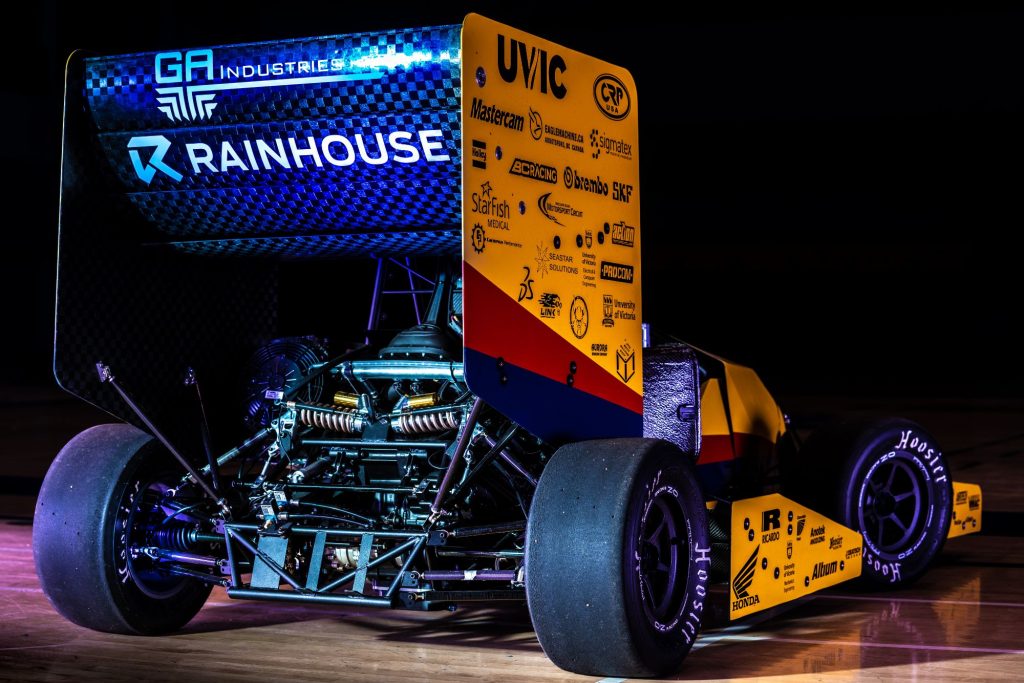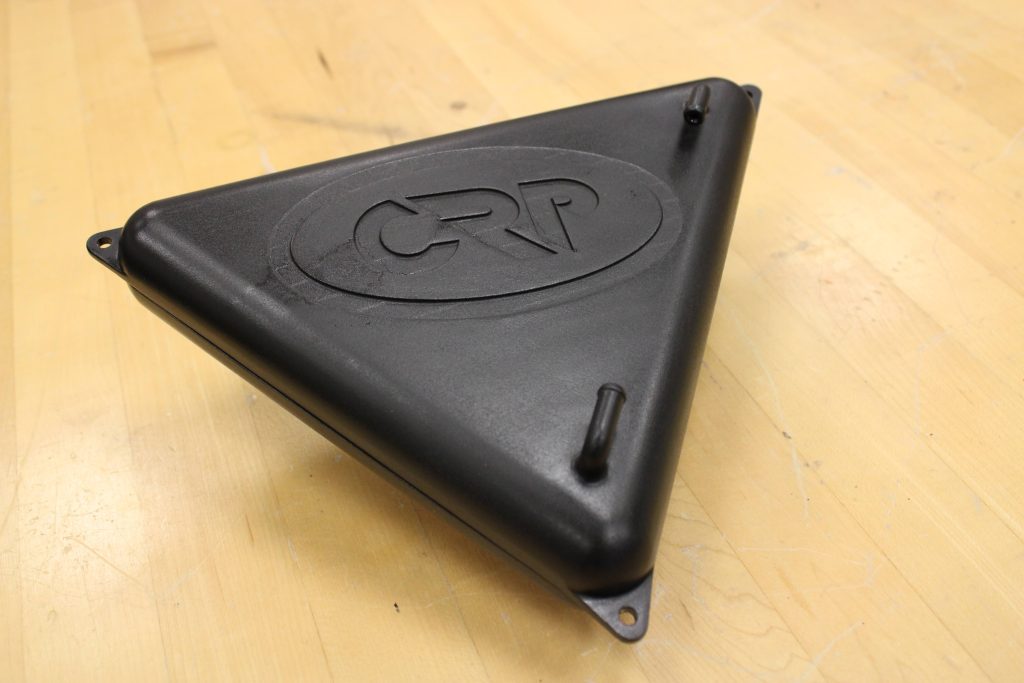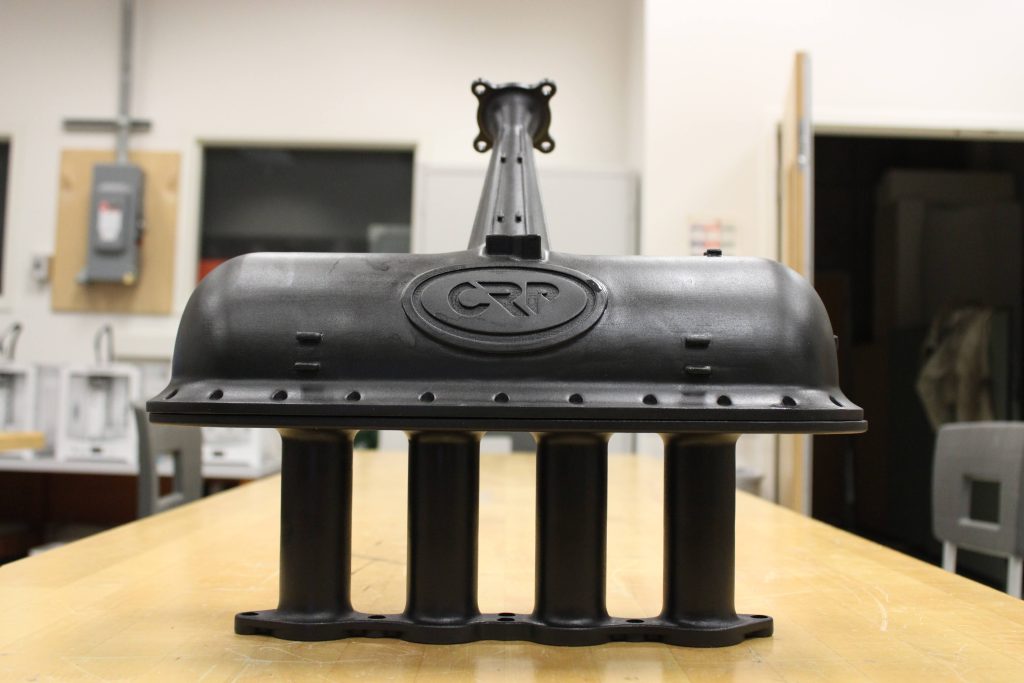Nominations are now open for the 3D Printing Industry Awards 2023. Who are the leaders in 3D printing? Find out on November 30th when the winners across twenty categories will be announced during a London-based live awards ceremony.
3D printing materials and service provider CRP USA has partnered with the University of Victoria’s UVic Formula SAE Racing team to develop 3D printed carbon fiber-filled racing car components.
As part of a long-term relationship, the two companies have produced several integral components, including the steering wheel and elements of the lubrication system. Carbon fiber-filled composite Windform materials have been used to 3D print the components through the Laser Sintering additive manufacturing process.
In a recently published case study, the companies claim that 3D printing with Windform materials has allowed the team to produce functional parts that are versatile and boast optimal mechanical properties.
“The durability of all the components 3D-printed by CRP USA is incredible. In all honesty, we ask a lot of these parts when we are out on the track, and they continue to deliver,” commented Luke Wooldridge, Powertrain Lead of UVic Formula Racing from the University of Victoria. “For example, this year, during testing, we struck a traffic cone hard enough to shear off the screw attaching the front wing to the chassis and bend our aluminum mounting arm without damaging the wing insert in Windform XT 2.0 attached to the other side.”

3D printing racing car components
One notable component was the team’s newly designed oil and water catch cans to better integrate with the chassis packaging. These parts were 3D printed from Windform SP, a carbon fiber-filled composite from Windform’s professional 3D printing material range.
The Windform SP parts are said to have held up particularly well to the high heat of the overflowing oil and coolant. Woolridge explains, “No significant damage was noted to either modules with water coolant temperature reaching ~125C and the oil reaching ~150C.”
Windform XT 2.0, another carbon fiber-filled composite, was used to 3D print a new steering wheel faceplate incorporating improved driver control switches. “Windform XT 2.0 provided a better-finished part as none of the in-house prints we made could provide the resistance to heat, impact, and direct sunlight needed from the part,” added Wooldridge.
While the main body of the steering wheel is 3D printed in Windform XT 2.0, the hand grips are produced using Windform RL, the thermoplastic elastomer from the windform range of materials.

Regarding the race car’s powertrain system, CRP USA has worked with the UVic team to develop several iterations of the oil pan over recent years. Each iteration has been manufactured using Windform SP due to its impact resistance and high-temperature resistance.
What’s more, Wooldridge highlights that the flexibility of the additive manufacturing process has allowed the team to reduce the overall height of the oil pan. This height reduction allows the team to drop the engine’s position in the chassis, lowering the car’s weight distribution and improving on-track performance.
Anti-sloshing features like one-way baffle doors have also been incorporated directly into the 3D printed parts. Additionally, CRP USA has leveraged Windforn SP to 3D print a custom oil pick-up to accompany the oil pan design.
The racing team’s aerodynamics system includes 3D printed front wing inserts produced using Windform XT 2.0. These inserts act as a transition from the central wing element to the two outer ones, providing the attachment points for the front wing onto the chassis.
Finally, the racing car’s intake was additively manufactured by CRP USA using Windform XT 2.0 in 2019. The intake is said to have performed incredibly well, lasting four consecutive seasons.
“During our competition, we had engine block temperatures reaching up to 125 C, and we experienced no warping or deformation at the mating surface between the cylinder head and intake. This thermal stability is critical to the reliability of our car as any deformation at this surface could lead to a catastrophic intake leak, which would put us out of the race,” explained Wooldridge.
The UVic racing team recently redesigned the engine intake, making it larger and optimizing its geometry to improve airflow into the engine. The intake has increased from a volume of 1.4L to 4.23L while retaining the 3D print resolution necessary to add sealing surfaces and sensor mounting directly into the intake without needing post-machining. The new intake was also 3D printed using Windform XT 2.0. “The larger intake allowed us to transition from bent to straight intake runners improving the simulated efficiency of our air flow by 100%,” Wooldridge added.

Additive manufacturing and motorsport
The development and production of cutting-edge racing cars is a key use case of additive manufacturing. Earlier this year, it was announced that leading US 3D printer manufacturer 3D Systems had sold four of its SLA 750 3D printers to the BWT Alpine F1 team. Using Accura Composite PIV material, these 3D printers are being used to produce components for wind tunnel testing. The team employs 3D Systems’ SLA and SLS technology to produce 25,000 3D printed racing car parts annually.
Similarly, it was reported last year that British Formula 1 team McLaren Racing uses Stratasys technology to 3D print 9,000 parts annually. The team leverages five Stratasys Neo 800 3D printers to 3D print aerodynamic racing car parts across its front and rear wing R&D programs and large elements of its car’s top-body and side bodywork.
Subscribe to the 3D Printing Industry newsletter to keep up to date with the latest 3D printing news. You can also follow us on Twitter, like our Facebook page, and subscribe to the 3D Printing Industry Youtube channel to access more exclusive content.
Are you interested in working in the additive manufacturing industry? Visit 3D Printing Jobs to view a selection of available roles and kickstart your career.
Featured image shows the 3D printed engine intake. Photo via CRP USA.


